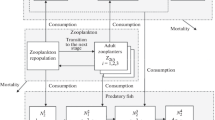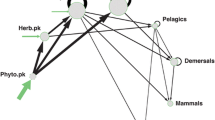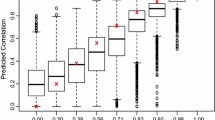Abstract
The simulation of biological systems is often plagued by a high level of noise in the data, as well as by models containing a large number of correlated parameters. As a result, the parameters are poorly identified by the data, and the reliability of the model predictions may be questionable. Bayesian sampling methods provide an avenue for proper statistical analysis in such situations. Nevertheless, simulations should employ models that, on the one hand, are reduced as much as possible, and, on the other hand, are still able to capture the essential features of the phenomena studied. Here, in the case of algae growth modeling, we show how a systematic model reduction can be done. The simplified model is analyzed from both theoretical and statistical points of view.
Similar content being viewed by others
References
Calvetti, D., Kuceyeski, A., Somersalo, E., 2008a. Sampling-based analysis of a spatially distributed model for liver metabolism at steady state. Multiscale Model. Simul. 7(1), 407–431.
Calvetti, D., Hageman, R., Occhipinti, R., Somersalo, E., 2008b. Dynamic Bayesian sensitivity analysis of a myocardial metabolic model. Math. Biosci. 212(1), 1–21.
Haario, H., Kalachev, L., Lehtonen, J., Salmi, T., 1999. Asymptotic analysis of chemical reactions. Chem. Eng. Sci. 54, 1131–1143.
Haario, H., Saksman, E., Tamminen, J., 2001. An adaptive Metropolis algorithm. Bernoulli 7(2), 223–242.
Haario, H., Laine, M., Lehtinen, M., Saksman, E., Tamminen, J., 2004. MCMC methods for high dimensional inversion in remote sensing. J. R. Stat. Soc. B 66(3), 591–607, 648–649, with discussion.
Haario, H., Laine, M., Mira, A., Saksman, E., 2006. DRAM: Efficient adaptive MCMC. Stat. Comput. 16, 339–354.
Malve, O., Laine, M., Haario, H., Kirkkala, T., Sarvala, J., 2007. Bayesian modelling of algal mass occurrences—using adaptive MCMC methods with a lake water quality model. Environ. Model. Softw. 7(22), 966–977.
Murray, J.D., 1993. Mathematical Biology. Springer, New York.
Ovaskainen, O., Luoto, M., Ikonen, I., Rekola, H., Meyke, E., Kuussaari, M., 2008. An empirical test of a diffusion model: predicting clouded apollo movements in a novel environment. Am. Nat. 171, 610–619.
Zheng, C., Ovaskainen, O., Saastamoinen, M., Hanski, I., 2007. Age-dependent survival analyzed with Bayesian models of mark-recapture data. Ecology 88(8), 1970–1976.
Author information
Authors and Affiliations
Corresponding author
Rights and permissions
About this article
Cite this article
Haario, H., Kalachev, L. & Laine, M. Reduced Models of Algae Growth. Bull. Math. Biol. 71, 1626–1648 (2009). https://doi.org/10.1007/s11538-009-9417-7
Received:
Accepted:
Published:
Issue Date:
DOI: https://doi.org/10.1007/s11538-009-9417-7




